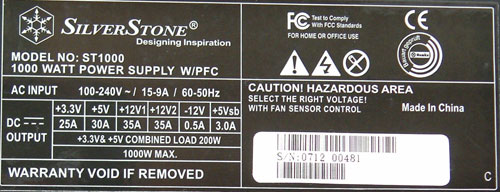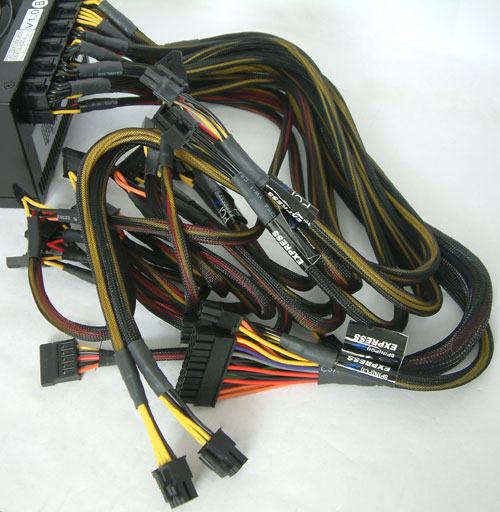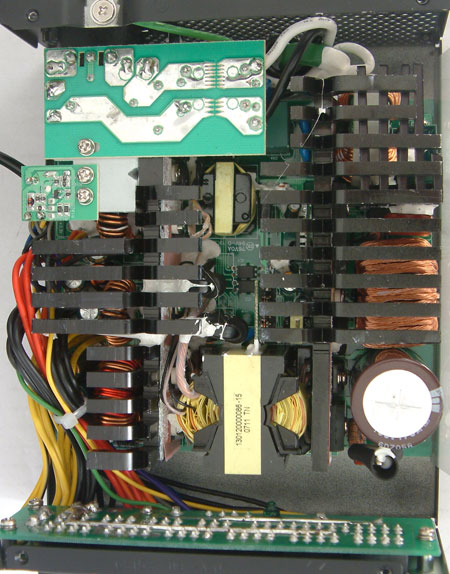Power Supply Roundup: Eight 1000W for the Extreme Users
by Christoph Katzer on December 11, 2007 9:30 PM EST- Posted in
- Cases/Cooling/PSUs
Silverstone Strider 1000W (ST1000-NV)

Silverstone sent us their Strider 1000W unit, which comes with detachable cables. Users can detach all of the cables, including the 24-pin ATX harness. This makes sense as Silverstone also offers a complete set of shorter harnesses for smaller cases. The housing is a standard black and cooling comes from a large 135mm fan. Since the PCB for the cable management takes some extra space, the Silverstone is longer than the Akasa PSU. The Strider 1000W comes in a huge package with maximum protection on all sides - expensive but a good way to prevent losses caused by shipping. Silverstone includes all the necessary parts for a quick installation.

The label shows the same rated values as the Akasa. The 12V rails are 35A each and the 3.3 and 5V rail have a combined power of 200W, which is plenty for today's systems.

All cables are nicely sleeved, as expected for any high-end power supply. PCI-E harnesses have a small sticker attached, which clearly states their purpose of powering up graphics cards. There are each six Molex and six SATA connectors - average for this roundup, though a few more wouldn't be bad. The max length of the peripheral connectors is 95cm for the SATA/Molex and 105cm for the two floppy connectors.

Other than the different main capacitor from Nippon Chemi-Con, there is almost no change at all from the Akasa model. The modular cable design is the only other difference. The use of a better capacitor in the primary parts is greatly appreciated, but as mentioned in the Akasa overview, the Strider power supply didn't make the 110% test and just stopped operating while applying the load. It worked fine right after the failure, however, which at least shows they have a very good OPP. A power supply doesn't need to deliver 10% more than stated on the label, and we perform this test only to see how much more power we can expect over the rated output.










29 Comments
View All Comments
brian_riendeau - Tuesday, December 18, 2007 - link
Depending on what site you check, I think you would find that very few 1000+ watt PSUs can sustain that output under load in real world conditions 100v to 120v. I am somewhat skeptical of that fact that 8 PSUs got tested here, and not a single one was labelled as a failure to provide on the rated specs.buzznut - Thursday, December 13, 2007 - link
So we have a line-up of 430 watt supplies, a comparison of 750-850 watt models, one of 1000 watts, and the "extreme" Power supplies at 1200W+.Anyone else notice the little gap there?
What about the 500-700 range, arguably the most popular with system builders right now? I can't even fathom why you would choose to ignore this segment.
Do ya think you could cover the more relevant enthusiest segment since this site is viewed by many enthusiests every day? I mean the ones that don't have $300 to blow on a power supply when a 650 watt one will do the job. Or ones that don't receive their equipment for free because they review hardware...
I buy a lot of equipment every year but I am not wealthy. I get tired of reviewers who tell me about the latest 700 dolla video card or other stuff I'll never be able to afford.
MadAd - Wednesday, December 12, 2007 - link
Nice touch adding in the Euro prices, a welcome change, infact a first in over 8 years of readership i think.Just a quick point, i think the import duty allowances on purchases abroad are very low, so flying to the US is fine for a holiday, but unless you are prepared to break the law and claim it as your pc you took out or something, then you would have to pay duty and vat as if youd had it shipped. Add to that any warranty claims may be null or awkward to service then it may not be the bargain it could be.
Christoph Katzer - Wednesday, December 12, 2007 - link
Wasn't really meant you would need to book a flight to go the States to buy a PSU... Of course there are import taxes (19-19,4% for France and Germany).PolymerTim - Wednesday, December 12, 2007 - link
Is there a power supply roundup coming out any time soon for something like 400W-700W. I've been reading through the PS forums lately and it seems like a lot of the recommended PS fall somewhere around the 450W-650W range and this seems to be missing from the roundups. I realize there were a lot of individual reviews in this range not too long ago, but there are several new options in this range in the last few months that I think deserve a review a bit more than yet another "ultra high" or "extreme" roundup. Just for illustration, I posted the date and title of every anandtech PS roundup since the new PS test methods came out 5 months ago. See the gap? We have 3 roundups between 730W-1300W and 1 roundup at 400W-450W.12-11 Power Supply Roundup: Eight 1000W for the Extreme Users
11-22 Power Supply Roundup: 730W to 900W
11-06 400-450W PSU Roundup
10-22 Ultra High-End PSU Roundup (1200W to 1300W)
Of course, many PS in this range were reviewed, but never in a roundup compared to other similar PS.
09-14 Seasonic S12II: 330W to 500W of Silence
09-11 Enermax Infiniti 650W
09-03 Zippy Serene (GP2-5600V)
08-27 Silver Power Blue Lightning 600W
08-08 Silverstone Decathlon DA650: A modular alternative
07-30 The Enermax Liberty - Getting long in the tooth, but still worth a look
07-24 Gigabyte's New Odin GT 800W Power Supply
07-18 PC Power & Cooling Silencer 750 Quad CF-Edition
07-13 The Single 12V Rail SilverStone Olympia OP650
Christoph Katzer - Wednesday, December 12, 2007 - link
Yeah this year still 600-650 watts...halcyon - Wednesday, December 12, 2007 - link
How about also another type of article:How to build a computer that does 90% of what people need (sans games) and runs on less than 30W?
800-1000W is insane and people should come around to understanding that.
strikeback03 - Wednesday, December 12, 2007 - link
I'm pretty sure even most laptops don't draw that little power. Not sure on the newer C2D processors, but I know the older Dothan Pentium M processors had a TDP in the 20-25W range. Add the rest of a system and you likely won't spend much time below 30W.Or check out some carputer setups. Using VIA mini-ITX motherboards with integrated processors and graphics and they still typically use 90-160W power supplies.
JarredWalton - Wednesday, December 12, 2007 - link
At idle, most of the moderate notebooks (14-15" chassis) sit at around 25W. Load, they'll get up to around 60W with IGP and 100W with something like an 8700M GT. 8800M GTX will probably push that closer to 125W (give or take 10W).jonnyGURU - Wednesday, December 12, 2007 - link
I'm game (no pun intended.)I built a machine with all on board components, a mobile AMD chip and solid state drives and it still required over 200W to run. Mind you it had a 7950 graphics card, but still.....